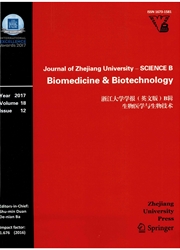

 中文摘要:
中文摘要:
肝纤维化会引起肝脏组织力学特性的变化,剪切波频散超声振动技术可以无创定量地测量肝脏组织的粘弹性。本研究采用大鼠肝纤维化动物模型,利用剪切波频散超声振动技术,基于粘弹性Zener模型同时得到大鼠肝纤维化组织的粘性和弹性系数。研究结果显示剪切波的速度在不同频率是频散的,肝脏组织的粘性对剪切波具有影响。基于Zener模型得到肝纤维化F0-F4期的弹性系数和粘性系数的平均值范围分别为0.76-2.93kPa和1.09-2.01Pa·s,弹性系数随着肝纤维化程度的加深存在明显递增的趋势。弹性系数的受试者工作特征曲线面积( AUROC)值为0.92(﹥=F2),0.98(﹥=F3),和0.99(F4),粘性系数的AUROC下值面积值为0.85(﹥=F2),0.71(﹥=F3)和0.73(F4)。弹性系数对肝纤维化进行分期相对于粘性系数更加灵敏。
 英文摘要:
英文摘要:
Shear wave dispersion ultrasound vibrometry( SDUV)enables quantitative measurement and noninvasive assessment of liver mechanical properties,such as viscoelasticity which is related to hepatic fibrosis. The present study simultaneously investigated viscous and elastic coefficient of liver fibrosis at different stages in a rat model using SDUV based on Zener model. The results showed that shear wave velocity was dispersive with fre-quency,and the viscocity of liver tissue has influence on shear wave. The mean values of the liver elasticity and the viscosity ranged from 0. 76 to 2. 93 kPa and from 1. 09 to 2. 01 Paos for F0-F4 fibrosis stages,respectively. The elasticity increases with the grade of liver fibrosis. The area under receiver operating characteristic( AUROC)"nbsp;values were 0 . 92(≥F2 ),0 . 98(≥F3 ),and 0 . 99( F4 )for elasticity and 0 . 85(≥F2 ),0 . 71(≥F3 ),and 0 . 73(F4)for viscosity. The results suggested that elasticity was more sensitive for the assessment of liver fibrosis staging compared to the viscosity.
 同期刊论文项目
同期刊论文项目
 同项目期刊论文
同项目期刊论文
 Optimal linear combination of ARFI, transient elastography and APRI for the assessment of fibrosis i
Optimal linear combination of ARFI, transient elastography and APRI for the assessment of fibrosis i The role of Viscosity Estimation for Oil-in-Gelatin Phantom in Shear Wave based Ultrasound Elastogra
The role of Viscosity Estimation for Oil-in-Gelatin Phantom in Shear Wave based Ultrasound Elastogra 期刊信息
期刊信息
